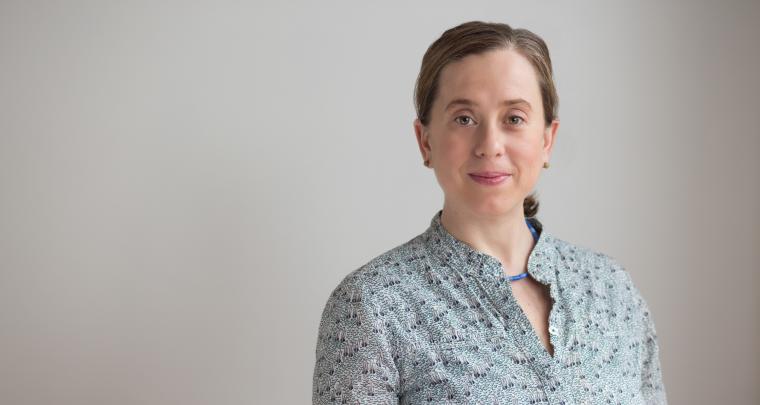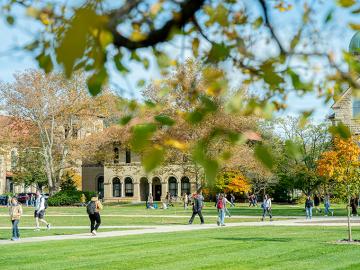The Art of E-Waste
February 1, 2013
Amanda Nagy

Julia Christensen made a name for herself early in her career with the Big Box Reuse Project, an exploration of how communities are renovating and reusing abandoned big box buildings in the United States. A more recent project, “Surplus Rising,” maps the narrative of industrial equipment salvaged from shuttered factory buildings.
You could say Christensen, an assistant professor of integrated media in the studio art department, finds inspiration in “stuff” — the stuff of industry, the stuff of consumerism, the stuff of economic crisis. Now, Christensen is turning her focus to the stuff of electronic waste. That thinking has landed her a prestigious Creative Capital grant worth $90,000 for a new endeavor to build DIY video projectors out of discarded electronic waste scavenged around the world.
Christensen is just the second artist from Ohio to win the support of Creative Capital, a nonprofit that works like a venture capital fund for the avant-garde. Her submission went through three rounds of evaluations to become a grantee. This year saw 2,700 proposals in three disciplines — performing arts, emerging fields (Christensen’s category), and literature — narrowed down to 700, then 216, before 46 projects were approved by a final panel.
Rather than just handing out grants, Creative Capital works in long-term partnerships with artists, provides guidance and advisory support, and helps artists build their individual capacity to sustain their careers beyond the grant term. “I am honored to be included on the list of 2013 Creative Capital grantees, and I look forward to dialogue with the Creative Capital community, across disciplines,” Christensen says. “My practice stems out of generative ideas which manifest in a spectrum of media—video, sound, photography, writing, web, and sculpture/installation. The long-term commitment of the Creative Capital resources will allow my current exploration about the life-cycles of e-waste to unfold in a variety of forms.”
Electronic waste is everywhere, Christensen explains, and at this point, the global community is unclear about how to dispose of it. It is continually shipped around the world by way of governments and multi-national corporations looking to discard it or make money off of it. The most common items are computers and cell phones, but e-waste also consists of vintage artifacts like overhead projectors from decades past. “The amount we’re generating is growing exponentially each year. A lot is trashed and put in landfills or exported to e-waste recycling facilities. What isn’t clear is how those facilities operate. Some are operated by multi-national corporations that mine the waste for precious materials; the question is, what happens to it after that point.”
The idea for the project grew from her work on “Surplus Rising” and travels to India and Hong Kong. For that project, she tracked down industrial machines that were formerly used in U.S. factories that closed down, and were then shipped to factories overseas for a second use. She discovered that machines were sometimes being exported as “trash” as a way to avoid taxation. Christensen’s journeys sent her into the underbelly of the international trash trade, leading to her current inquiry into e-waste.
Much like her scrupulous investigation of factory machines for “Surplus Rising,” Christensen will follow the trail of e-waste as it is stripped down and shipped around the globe. The journey, however, will begin right here in Oberlin. “Right now, I’m trying to learn more about how e-waste originates locally in Ohio and in the Great Lakes region. For instance, what do we do here on campus with our outdated electronics?”
A multidisciplinary artist and professional musician, Christensen has experience with building electronics. Her background in electronic music and art has led her to build radio transmitters, self-designed musical instruments, and circuits to support her installation work. However, the art and craft of building video projectors is a new prospect. “Because of their hacked, DIY nature, each projector will have unique output quirks, like pixelated resolution or non-traditional frame rate. I can build them to my own specification, and make video and media pieces specifically for each projector. In this way, the machines become sculptural.”
She will use imagery gathered from the e-waste landscapes encountered on her journeys to make the pieces associated with the projectors. “I like to work in ways that allow issues to be raised without being didactic. I’m tying questions and content to the form of artwork so that questions and discussions can be raised by the material itself.”
Tags:
You may also like…
The Impact of Collective Action
March 27, 2025
How our work as a community helped us achieve carbon neutrality.
Oberlin Named Top Producer of Fulbright Students for 2024-25
February 25, 2025
Nineteen Oberlin College and Conservatory students and alumni were awarded Fulbright grants for the 2024-25 academic year, making the college the No. 1 producer of honorees among U.S. undergraduate-only institutions.
Oberlin’s Sustainable Infrastructure Program Reaches Major Milestone
December 4, 2024
Geothermal heating and cooling system comes online, supports Oberlin reaching 100 percent carbon neutrality by 2025.


